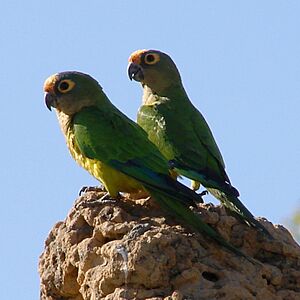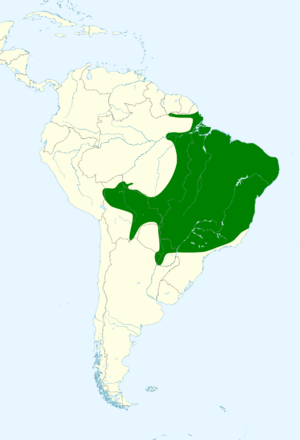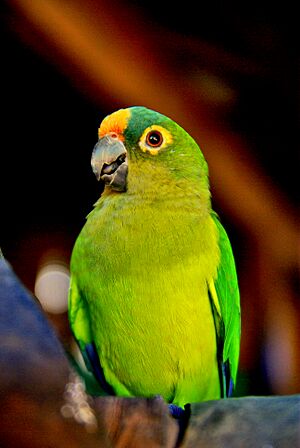Peach-fronted parakeet facts for kids
Quick facts for kids Peach-fronted parakeet |
|
|---|---|
 |
|
| On a termite mound in Minas Gerais, Brazil | |
| Conservation status | |
| Scientific classification | |
| Genus: |
Eupsittula
|
| Species: |
aurea
|
 |
|
| Synonyms | |
|
|
The peach-fronted parakeet (Eupsittula aurea) is a colorful bird. It is a type of parrot found in South America. People who keep birds sometimes call it the peach-fronted conure. You can find this parakeet in countries like Argentina, Bolivia, Brazil, Paraguay, Peru, and Suriname.
Contents
About the Peach-fronted Parakeet
Scientists give every animal a special two-part name. The peach-fronted parakeet got its scientific name, Psittacus aurius, in 1788. This was done by a German naturalist named Johann Friedrich Gmelin. He based his description on earlier notes from other naturalists.
Later, in 1853, French naturalist Charles Lucien Bonaparte placed this bird in a new group called Eupsittula. The name Eupsittula means "good little parrot" in Ancient Greek and Modern Latin. The second part of its scientific name, aurea, is Latin for "golden." This bird is unique because it does not have different types or subspecies.
What Does It Look Like?
The peach-fronted parakeet is about 23 to 28 cm (9 to 11 in) long. It weighs between 74 and 94 g (2.6 to 3.3 oz). Male and female parakeets look the same.
Adults have a peachy-orange color on their forehead and the front of their head. The back of their head is a dull blue. Around their eyes, they have bare yellow skin. Their neck, upper body, and tail are a dull green. Their cheeks and throat are a light olive-brown. This color fades into a greenish-yellow on their chest, belly, and under their tail. Their wings are mostly green on top. Underneath, they are yellow-green with greenish-blue flight feathers. Young birds look much like adults. However, they have less orange and blue on their heads.
Where Do They Live?
The peach-fronted parakeet lives in many parts of South America. Its home stretches from southern Suriname down through most of eastern Brazil. It also lives in eastern Bolivia, southeastern Peru, and parts of Paraguay and Argentina.
These birds live in many different places. They can be found in open areas and wooded spots. They like palm groves, savannas, and forests along rivers. They also live in grasslands with shrubs and scattered trees. Sometimes, you can even spot them in cities!
Behavior and Habits
How They Move Around
Peach-fronted parakeets seem to move around locally. They do this to find food. However, they do not have a regular pattern for their movements.
What They Eat
These parakeets often look for food on the ground. They mainly eat seeds from many different plants. They also enjoy eating termites and insect larvae. You might see them feeding in farm fields. They eat both before the crops are ready and after the harvest.
Reproduction
The peach-fronted parakeet's breeding season varies by location. In Peru, they breed in June and July. In central Brazil, it is between September and December. Scientists are still learning about their breeding season in other areas.
These birds usually dig their nests inside termite mounds. They use both mounds on the ground and those in trees. A female parakeet typically lays two to four eggs. In zoos, the eggs hatch after 23 days. The young birds are ready to fly about 48 days after hatching.
Their Calls
The peach-fronted parakeet has a distinct call. It sounds like a "rolling 'vreet vreet-vreet-vreet-vreet'." The sound changes from a low pitch to a very high pitch.
Status and Conservation
The IUCN (International Union for Conservation of Nature) has listed the peach-fronted parakeet as "Least Concern." This means they are not currently in danger of disappearing. They live across a very large area. Even though their exact population size is not known, it is believed to be stable.
One main threat to these birds is the pet trade. People sometimes catch them to sell as pets. The parakeet is common in Suriname and very plentiful in Paraguay. In Brazil, it is the most common type of Eupsittula parakeet. Clearing land for farms might even help them in some ways. However, sadly, many young birds are taken from their nests to be sold as pets. Many of these young birds do not survive.
Images for kids






